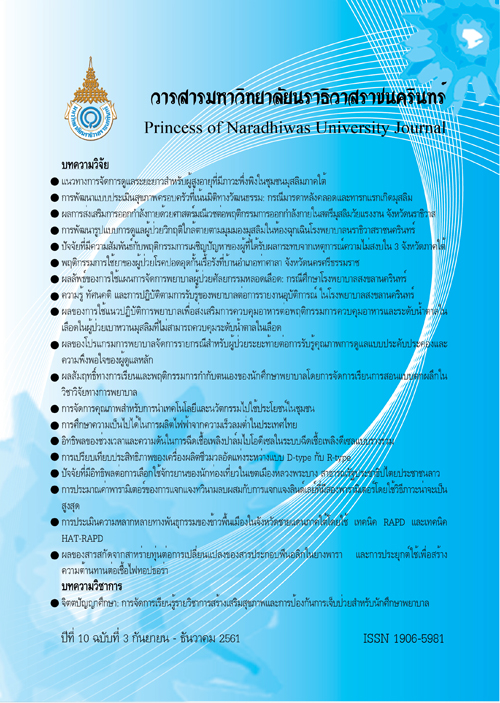Parameter Estimation of the Mixed Negative Binomial and Two-Parameter Lindley Distribution: Maximum Likelihood Method
Keywords:
ภาวะน่าจะเป็นสูงสุด, การประมาณค่าพารามิเตอร, การแจกแจงทวินามลบผสมกับการแจกแจงลินดเลย์ที่มีสองพารามิเตอร์การจำาลอง, สถิติทดสอบแอนเดอร์สันดาร์ลิงสำาหรับข้อมูลไม่ต่อเนื่องAbstract
Recently, the negative binomial two-parameter Lindley distribution. In this article, the parameter
estimation of the negative binomial two-parameter Lindley distribution using the maximum likelihood estimation method will be developed. A Monte Carlo simulation is applied in order to compare the efficiency of
model parameter estimation using the the maximum likelihood estimation method based on mean square
error of estimates. The finding results of simulation study was show that the the maximum likelihood estimates seem to have high-efficiency when the sample size becomes large. In addition, the negative binomial two-parameter Lindley distribution is applied to real data sets, we found that it can be fitted to the selected data sets. Each data set is fitted with the negative binomial two-parameter Lindley distribution, Poisson, negative binomial, and negative binomial Lindley distribution using the maximum likelihood estimation method. By comparing these results based on the p-value of Anderson-Darling goodness of fit test for fit test, it shows that the negative binomial two-parameter Lindley distribution provided the best fit whencomparing to the other distributions
References
Applied Mathematical Sciences, 7, 1093-1105.
Cameron, A. C., & Trivedi, P. K. (1998). Regression analysis of count data. Cambridge, United Kingdom:Cambridge University Press.
Denthet, S., Thongteeraparp, A., & Bodhisuwan, W. (2016). Mixed distribution of negative binomial and two-parameter Lindley distributions. In 2016 12th International Conference on Mathematics,
Statistics, and Their Applications (ICMSA), (pp. 104-107), Banda Aceh, Indonesia.
Gómez-Déniz, E., Sarabia, J. M., & Calderín-Ojeda, E. (2008). Univariate and multivariate versions of the negative binomial-inverse Gaussian distributions with applications. Insurance: Mathematics and Economics, 42, 39-49.
Greenwood, M., & Yule, G. U. (1920). An inquiry into the nature of frequency distributions representative of multiple happenings with particular reference to the occurrence of multiple attacks of disease or of repeated accidents. Journal of the Royal statistical society, 83, 255-279.
Klugman, S.A., Panjer, H.H. & Willmot, G.E. (2008). Loss Models: From Data to Decision. John Wiley and Sons, USA, 101-159.
Kongrod, S., Bodhisuwan, W.,& Payakkapong, P. (2014). The negative binomial-Erlang distribution with applications. International journal of Pure and Applied Mathematics, 92, 389-401.
Lemaire, J. (1979). How to define a Bonus-Malus system with an exponential utility function. ASTIN Bulletin: The Journal of the IAA, 10, 274-282.
Lord, D. & Geedipally, R.S. (2011). Distribution and its application. Mathematics and Computers in Simulation, 79, 279–287.
Nadarajah, S., & Kotz, S. (2006). The beta exponential distribution. Reliability engineering & system safety, 91, 689-697.
Panjer, H. H., & Willmot, G. E. (1981). Finite sum evaluation of the negative binomial-exponential model. ASTIN Bulletin: The Journal of the IAA, 12, 133-137.
Pudprommarat, C., Bodhisuwan, W., & Zeephongsekul, P. (2012). A new mixed negative binomial distribution. Journal of Applied Sciences (Faisalabad), 12, 1853-1858.
R Core Team, & R: A Language. (2015). Environment for Statistical Computing, R Foundation for Statistical Computing. Vienna.
Rainer, W. (2000). Econometric Analysis of Count Data. Berlin, Germany: Library of Congress Control, Springer-Verlag.
Saengthong, P., & Bodhisuwan, W. (2013). Parameters Estimation Methods for the Negative Binomial-Crack Distribution and Its Application. Journal of Science and Technology Mahasarakham University, 33, 125-130.
Shanker, R., & Mishra, A. (2013). A two-parameter Lindley distribution. Statistics in Transition new series, 1, 45-56.
Wang, Z. (2011). One mixed negative binomial distribution with application. Journal of statistical Planning and Inference, 141, 1153-1160.
Yamrubboon, D., Bodhisuwan, W., Pudprommarat, C., & Saothayanun, L. (2017). The Negative Binomial-Sushila Distribution with Application in Count Data Analysis. Thailand Statistician, 15, 69-77.
Zamani, H., & Ismail, N. (2010). Negative binomial-Lindley distribution and its application. Journal of Mathematics and Statistics, 6, 4-9.




